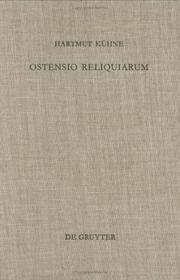| Listing 1 - 2 of 2 |
Sort by
|

ISBN: 3110165694 3110804948 9783110165692 Year: 2000 Volume: 75 Publisher: Berlin ; New York W. De Gruyter
Abstract | Keywords | Export | Availability | Bookmark
 Loading...
Loading...Choose an application
- Reference Manager
- EndNote
- RefWorks (Direct export to RefWorks)
Gegenstand der Analyse ist der Brauch des Reliquienfests (Heiltumsweisung, ostensio reliquiarum), bei dem die Reliquien einer Kirche öffentlich zur Schau gestellt wurden. Auf der Grundlage von Untersuchungen zu 24 spätmittelalterlichen Reliquienfesten im römisch-deutschen Regnum werden die liturgisch-zeremoniellen Muster dieser Feste und ihre Funktionen, besonders im Bereich des Ablaßwesens und der Herrschaftsrepräsentation (speziell Residenzbildung), dargestellt. The object analyzed here is the custom of the festival of relics (ostensio reliquiarum), at which the relics of a church were publicly displayed. On the basis of an examination of 24 late medieval relic festivals in the Roman-German regnum, the liturgical-ceremonial patterns of these festivals and their functions are presented, especially in the area of the system of indulgences and the representation of governing (especially the formation of residences).
Relics --- Reliques --- Germany --- Allemagne --- Church history --- Histoire religieuse --- Reliquaries, Romanesque --- Religious life and customs --- 231.739 --- 264-052 --- 235.3*15 --- -Reliquaries, Romanesque --- -Relics and reliquaries, Romanesque --- Romanesque reliquaries --- Relics and reliquaries --- Bones --- Religious articles --- Relikwieën --- Verering van relikwieën --- Hagiografie: vereringsgeschiedenis --- Religious life and customs. --- -Relikwieën --- 235.3*15 Hagiografie: vereringsgeschiedenis --- 264-052 Verering van relikwieën --- 231.739 Relikwieën --- -235.3*15 Hagiografie: vereringsgeschiedenis --- Relics and reliquaries, Romanesque --- Holy Roman Empire --- History --- Relics - Germany --- Reliquaries, Romanesque - Germany --- Germany - Religious life and customs
Book
ISBN: 0429535783 0429260164 9780429260162 9780429522314 0429522312 9780429535789 9780429550485 0429550480 9780367200183 036720018X 9780367202071 0367202077 Year: 2020 Publisher: London: Routledge,
Abstract | Keywords | Export | Availability | Bookmark
 Loading...
Loading...Choose an application
- Reference Manager
- EndNote
- RefWorks (Direct export to RefWorks)
"Arising from a conference organised by the British Archaeological Association and held in Oxford, the twenty-three papers in this volume explore the material culture of sanctity in Latin Europe and the Mediterranean between c. 1000 and c. 1220, with a focus on the ways in which saints and relics were enshrined, celebrated and displayed. Reliquary cults were particularly important during the Romanesque period, both as a means of affirming or promoting identity, and as a conduit for the divine. This book covers the geography of sainthood, the development of spaces for reliquary display, the distribution of saints across cities, the use of reliquaries to draw attention to the attributes, and the virtues or miracle-working character of particular saints. Individual essays range from case studies on Verona, Hildesheim, Trondheim and Limoges, the mausoleum of Lazarus at Autun and the patronage of Mathilda of Canossa, to reflections on local pilgrimage, the deployment of saints as physical protectors, the use of imagery where possession of a saint was disputed, island sanctuaries, and the role of Templars and Hospitallers in the promotion of relics from the Holy Land. This book will serve historians and archaeologists studying the Romanesque period, and those interested in material culture and religious practice in Latin Europe and the Mediterranean c.1000-c.1220"--
Christian saints in art --- Art, Romanesque --- Architecture, Romanesque --- Reliquaries, Romanesque --- Christian pilgrims and pilgrimages --- Christianity and art --- Art and Christianity --- Art --- Pilgrims and pilgrimages, Christian --- Christian shrines --- Pilgrims and pilgrimages --- Relics and reliquaries, Romanesque --- Romanesque reliquaries --- Romanesque architecture --- Architecture, Medieval --- Romanesque art --- Art, Medieval --- Christian art and symbolism --- History
| Listing 1 - 2 of 2 |
Sort by
|

 Search
Search Feedback
Feedback About UniCat
About UniCat  Help
Help News
News